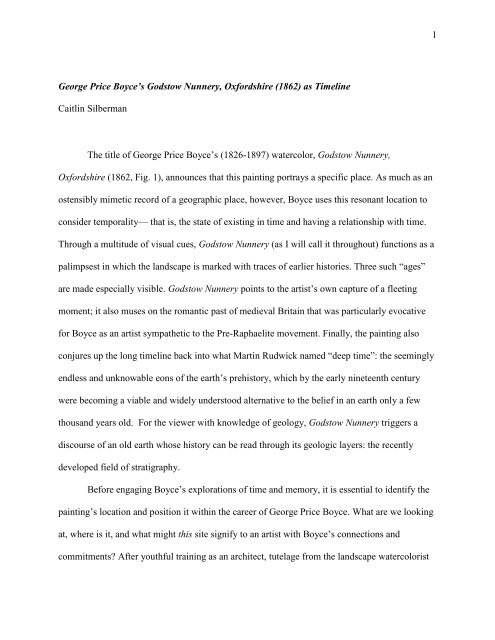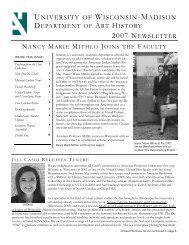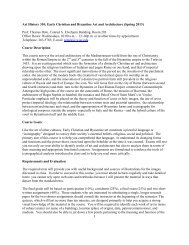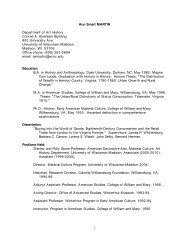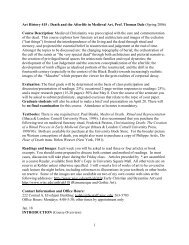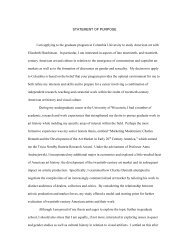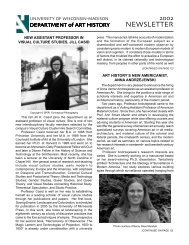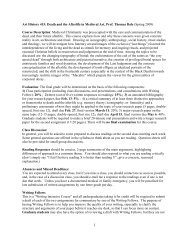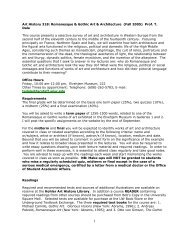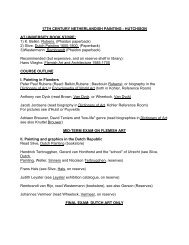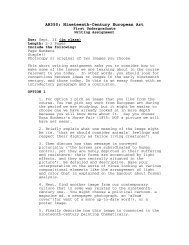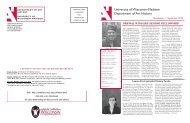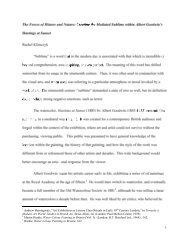George Price Boyce's Godstow Nunnery, Oxfordshire as Timeline
George Price Boyce's Godstow Nunnery, Oxfordshire as Timeline
George Price Boyce's Godstow Nunnery, Oxfordshire as Timeline
You also want an ePaper? Increase the reach of your titles
YUMPU automatically turns print PDFs into web optimized ePapers that Google loves.
<strong>George</strong> <strong>Price</strong> Boyce’s <strong>Godstow</strong> <strong>Nunnery</strong>, <strong>Oxfordshire</strong> (1862) <strong>as</strong> <strong>Timeline</strong><br />
Caitlin Silberman<br />
The title of <strong>George</strong> <strong>Price</strong> Boyce’s (1826-1897) watercolor, <strong>Godstow</strong> <strong>Nunnery</strong>,<br />
<strong>Oxfordshire</strong> (1862, Fig. 1), announces that this painting portrays a specific place. As much <strong>as</strong> an<br />
ostensibly mimetic record of a geographic place, however, Boyce uses this resonant location to<br />
consider temporality— that is, the state of existing in time and having a relationship with time.<br />
Through a multitude of visual cues, <strong>Godstow</strong> <strong>Nunnery</strong> (<strong>as</strong> I will call it throughout) functions <strong>as</strong> a<br />
palimpsest in which the landscape is marked with traces of earlier histories. Three such “ages”<br />
are made especially visible. <strong>Godstow</strong> <strong>Nunnery</strong> points to the artist’s own capture of a fleeting<br />
moment; it also muses on the romantic p<strong>as</strong>t of medieval Britain that w<strong>as</strong> particularly evocative<br />
for Boyce <strong>as</strong> an artist sympathetic to the Pre-Raphaelite movement. Finally, the painting also<br />
conjures up the long timeline back into what Martin Rudwick named “deep time”: the seemingly<br />
endless and unknowable eons of the earth’s prehistory, which by the early nineteenth century<br />
were becoming a viable and widely understood alternative to the belief in an earth only a few<br />
thousand years old. For the viewer with knowledge of geology, <strong>Godstow</strong> <strong>Nunnery</strong> triggers a<br />
discourse of an old earth whose history can be read through its geologic layers: the recently<br />
developed field of stratigraphy.<br />
Before engaging Boyce’s explorations of time and memory, it is essential to identify the<br />
painting’s location and position it within the career of <strong>George</strong> <strong>Price</strong> Boyce. What are we looking<br />
at, where is it, and what might this site signify to an artist with Boyce’s connections and<br />
commitments? After youthful training <strong>as</strong> an architect, tutelage from the landscape watercolorist<br />
1
David Cox in 1847 inspired Boyce chose to pursue a career in painting. 1 Though b<strong>as</strong>ed in<br />
London, Boyce traveled widely in search of landscapes to paint and in the late summer of 1862<br />
went to Oxford for this purpose. <strong>Godstow</strong> <strong>Nunnery</strong> and At Binsey, Near Oxford (Fig. 2) resulted<br />
from this expedition. 2 Both works were painted en plein air (outdoors) in an approach practiced<br />
by many members of the Pre-Raphaelite Brotherhood, a group of young vanguard artists whose<br />
style and ethos Boyce began to adopt from the late 1850s. 3 Boyce’s diaries and inscriptions on<br />
painting the suggest that <strong>Godstow</strong> <strong>Nunnery</strong> w<strong>as</strong> painted in either August or in September. While<br />
the front of the painting is signed and dated September 1862, an inscription on the reverse states<br />
“<strong>Godstow</strong> <strong>Nunnery</strong>, near Oxford, G. Boyce, August 1862, 6.15 pm.” 4 On August 18, Boyce<br />
recorded a conversation with the daughter of the innkeeper of the Trout Inn near <strong>Godstow</strong>, who<br />
told him that William Holman Hunt had painted The Hireling Shepherd (1851) around the<br />
nunnery. 5 For a modern painter in the 1860s, <strong>Godstow</strong> combined the artistic attraction of ruins<br />
(long prized for their “picturesque” qualities, though Boyce’s painting does not obey the<br />
compositional strictures of the picturesque mode of landscape painting) and an <strong>as</strong>sociation with a<br />
dramatic and rather racy moment in British history. It w<strong>as</strong> also within e<strong>as</strong>y reach of London,<br />
where the greatest number of Victorian artists w<strong>as</strong> concentrated and where the major artistic<br />
societies and opportunities for exhibition were found.<br />
1 Allen Staley, The Pre-Raphaelite Landscape (Oxford: Clarendon Press, 1973), 107.<br />
2 Both watercolors were submitted to the Old Water Colour Society and shown at their annual exhibition in 1864 ,<br />
the year in which Boyce w<strong>as</strong> elected an <strong>as</strong>sociate member of that body. (The Eye of a Collector: Works from the<br />
Collection of Stanley J. Seeger [New York: Sotheby's, 2001], 94.)<br />
3 Staley, The Pre-Raphaelite Landscape, 107-9. Allen Staley records that although Boyce had met many members of<br />
the Pre-Raphaelite Brotherhood in the early 1850s and become particularly friendly with Dante Gabriel Rosetti,<br />
Boyce did not employ the Brotherhood’s characteristic vivid coloration, preference for bright sunshine, and high<br />
degree of detail until late in the decade.<br />
4 The Eye of a Collector, 94.<br />
5 <strong>George</strong> <strong>Price</strong> Boyce and Virginia Surtees, The Diaries of <strong>George</strong> <strong>Price</strong> Boyce (Norwich: Real World Press, 1981),<br />
35.<br />
2
Sited along the Thames or Isis 6 roughly 2.5 miles northwest of Oxford, the Benedictine<br />
nunnery at <strong>Godstow</strong> (“God’s Place”) w<strong>as</strong> established in the twelfth century and dedicated to St.<br />
Mary and St. John the Baptist (Figs 3, 4). It persisted <strong>as</strong> a nunnery until 1539, when mon<strong>as</strong>tic<br />
orders were disbanded under King Henry VIII’s order of dissolution. After centuries in private<br />
hands, the site w<strong>as</strong> in ruins by the early eighteenth century. 7 The taller, windowed structure at the<br />
right-hand end of the wall in Boyce’s painting corresponds to a chapel, “originally late [fifteenth]<br />
century,” in the southe<strong>as</strong>t corner of the nunnery complex. 8 The viewer is thus looking north at<br />
the span of the nunnery’s southern wall. To the far left, a house-shaped hayrick straddles the<br />
ancient wall of the nunnery; the hayrick’s shape mimics that of a thatch-roofed building beside it.<br />
This l<strong>as</strong>t must be a modern accretion rather than a part of the ancient nunnery, <strong>as</strong> the chapel w<strong>as</strong><br />
the only building even partially intact in the nineteenth century.<br />
<strong>Godstow</strong>’s fame rests on its being known <strong>as</strong> the burial place of a king’s mistress. The<br />
beautiful Rosamund Clifford (or “Fair Rosamund”) incurred the wrath of King Henry II’s jealous<br />
wife, Queen Eleanor of Aquitaine. Though hidden in a labyrinth by the rightfully concerned<br />
King Henry, she w<strong>as</strong> tracked down in Henry’s absence by Queen Eleanor, who offered her a<br />
choice of a dagger or poison. Rosamund chose the poison. Some legends have Rosamund<br />
interred at <strong>Godstow</strong> after this murder, while others claim that she retired here <strong>as</strong> a nun and died a<br />
natural death. In either event a number of legends sprang up of roses blooming, trees blossoming,<br />
and sweet smells emanating from her at tomb at <strong>Godstow</strong>, though by Boyce’s time the precise<br />
location of her burial w<strong>as</strong> not known. 9<br />
6 In the environs of Oxford, the river Thames is called the Isis.<br />
7 Alan Crossley et al., "Wolvercote: Site and Remains of <strong>Godstow</strong> Abbey," A History of the County of Oxford 12,<br />
Wootton Hundred (South) including Woodstock (1990), 311-313.<br />
8 Alan Crossley et al., "Wolvercote: Site and Remains of <strong>Godstow</strong> Abbey," 311-313.<br />
9 An extensive collection of writings on Rosamund and <strong>Godstow</strong> <strong>Nunnery</strong> are collected at the “<strong>Godstow</strong> <strong>Nunnery</strong>”<br />
page of John Eade’s website Where the Thames Smooth Waters Glide .<br />
3
In Boyce’s painting, the p<strong>as</strong>sage of time weighs heavily on the nunnery, the long, low<br />
bulk of which is overgrown with ivy and towered over by more recent trees, some of which must<br />
be growing within the nunnery walls. The stretch of the nunnery walls also provides a contr<strong>as</strong>t to<br />
the more modern lock that cuts through the foreground. First built in 1790, <strong>Godstow</strong> Lock allows<br />
boats to byp<strong>as</strong>s the f<strong>as</strong>t-moving weir that makes up the main body of the Thames in this<br />
vicinity. 10 The lock gate serves to regulate the level of water in the lock; descent through this<br />
gate leads the boater to a lower water level. This is what the two men in the painting must have<br />
just done; their bright caps peep and boat pole out from the sunken lock. They are traveling<br />
downstream, towards Oxford. Continuing in the direction of their travel, a young child with a<br />
switch or pole dawdles on the riverbank. He, too, wears a cap, and the p<strong>as</strong>sage from youth to<br />
adult may be conjured up by this visual rhyme. The small white object between the child and the<br />
boaters on the far bank is a hitching post; if traveling upstream, one could tie one’s boat to it<br />
while opening the lock gate, which w<strong>as</strong> operated manually.<br />
All these incidental details— and the inscription on the painting’s reverse, indicating<br />
even the time of the scene— point to a moment frozen in time, historically particular and<br />
empirically observed. Certainly contemporaries took Boyce’s landscape paintings <strong>as</strong> accurate<br />
transcriptions of the scenes he viewed: an Art Journal critic in 1864 opined, “Mr Boyce[...]<br />
cherishes a single eye for simple nature, which, in the reverence of deep feeling, he ventures not<br />
to alter, or even to compose. The art of this artist[...] is artless.” 11 This and other critics were<br />
mistaken, however; Boyce h<strong>as</strong> altered the geographic features of <strong>Godstow</strong> significantly. A<br />
composite image from Google Earth (Fig. 3) and Victorian photographs by Henry Taunt (Figs 5,<br />
10 The right side of the Google Earth image (Fig. 3) shows one point at which the f<strong>as</strong>t-moving weir and the slower,<br />
gate-regulated lock are separated by a barrier. Today’s lock gate is further downstream.<br />
11 Critic quoted in Christopher Newall, “Understanding the Landscape,” in Pre-Raphaelite Vision: Truth to Nature,<br />
ed. Alan Staley et al., (London: Tate, 2004), 87.<br />
4
6) show that the river runs roughly parallel to the e<strong>as</strong>tern wall of the nunnery; it swings west<br />
slightly once downstream from the ruined chapel, but stays e<strong>as</strong>t of the nunnery complex for some<br />
distance downstream. Boyce’s painting, though, gives the impression that the river runs in front<br />
of, rather than e<strong>as</strong>t of, the southern wall that he paints. Comparing Figure 1, Boyce’s painting, to<br />
a photograph taken in 1885 (Fig. 6), shows the extent of the change. 12 The south wall and ruined<br />
nunnery are seen in an identically frontal view, but in Boyce’s painting the river runs in a far<br />
more e<strong>as</strong>t-westerly direction. For compositional purposes, he h<strong>as</strong> rerouted the river to flow at a<br />
shallow angle to, if not quite parallel to, the southern wall. The purposes that adjustment might<br />
serve will be explored in the final section of this essay.<br />
<strong>Godstow</strong> <strong>Nunnery</strong> reveals Boyce implementing certain qualities of paintings by the Pre-<br />
Raphaelite Brotherhood. Although his early work reproduced the picturesque compositions,<br />
strong contr<strong>as</strong>t of light and dark (chiaroscuro) and sketchy execution of his first painting m<strong>as</strong>ter,<br />
David Cox, Boyce’s friendliness with many artists in the Pre-Raphaelite circles (particularly the<br />
Brotherhood’s co-founder, Dante Gabriel Rossetti) came to affect his style by the late 1850s. 13<br />
Boyce’s friendship with the influential art critic John Ruskin further cemented Boyce’s ties to the<br />
doctrine of “truth to nature”: that is, Ruskin’s imperative in his manifesto on the state of British<br />
art, Modern Painters (1843). In a call heeded by the Pre-Raphaelite Brotherhood of young avant<br />
garde artists, Ruskin urged artists to eschew the tradition of learning to paint the outdoors from<br />
imitating the Old M<strong>as</strong>ters and rather to “go to Nature in all singleness of heart[…] rejecting<br />
12 The lock gate in Taunt’s 1885 photograph (Fig. 6) may or may not be in the same location <strong>as</strong> in Boyce’s 1862<br />
painting; Parliamentary reports indicate that the <strong>Godstow</strong> lock gate w<strong>as</strong> replaced in 1872, but not whether the<br />
location w<strong>as</strong> altered. (“General Report of the Proceedings of the Conservators of the River Thames, from the 1st<br />
January to the 31st December 1874[…],” Accounts and Papers of the House of Commons 19 [1875], 413.) Certainly,<br />
though, the river w<strong>as</strong> not rerouted.<br />
13 Christopher Newall and Judy Egerton, <strong>George</strong> <strong>Price</strong> Boyce (London: Tate, 1987), 11; Staley, The Pre-Raphaelite<br />
Landscape, 107-9.<br />
5
nothing, selecting nothing, and scorning nothing.” 14 In <strong>Godstow</strong> <strong>Nunnery</strong>, Boyce’s minute<br />
attention to detail and the use of strong, bright colors in a sun-drenched atmosphere—<br />
abandoning chiaroscuro— are the clearest markers of Ruskinian and Pre-Raphaelite influence.<br />
Newall and Egerton also attribute Boyce’s choice of “countrified” landscapes, populated with<br />
“timeworn buildings and landscapes seen in the very process of elemental decay and<br />
reconstitution,” to Ruskin’s art manual, The Elements of Drawing (1857), which advocated such<br />
scenes <strong>as</strong> subjects. 15<br />
The emph<strong>as</strong>is on the foreground, without a clear recession into a distant background, is<br />
similarly Pre-Raphaelite, but taken to an extreme by Boyce. Comparing <strong>Godstow</strong> <strong>Nunnery</strong> to<br />
Near Binsey, Oxford (Fig. 2) demonstrates that on his Oxford trip, Boyce eschewed deep<br />
perspective and used saturated color throughout his scenes. There is none of the atmospheric<br />
perspective that makes colors in the distance look to the human eye paler and more blue-gray.<br />
This flattens the scenes’ depth, making them look shallow in comparison to more traditional, ie<br />
Claudean landscapes; that is, those composed according to the still-dominant landscape tradition<br />
of the French artist Claude Lorrain (c.1600-1682). Some hallmarks of the Victorian landscape<br />
vocabulary with a lineage back to Claude can be found in found in The Harvest Moon (1855,<br />
Fig. 8) by John Linnell, an artist a generation older than Boyce. In this image, clearly defined<br />
paths lead the viewer’s eye from the foreground into the background. Atmospheric perspective<br />
contributes to the sense of a deep space, while framing elements at the sides of the image<br />
(repoussoirs) further restrain a wandering eye and keep the foreground dim in comparison to the<br />
middle and far distances.<br />
14 John Ruskin, Modern Painters I, 1843, (Reprint, New York: National Library Association, n.d.), 428.<br />
15 Newall and Egerton, <strong>George</strong> <strong>Price</strong> Boyce, 21. The subject of the ruin <strong>as</strong> an ideal subject for landscape h<strong>as</strong> a long<br />
history in British art, notably arising from the aesthetic doctrines of the picturesque and the sublime in the eighteenth<br />
century.<br />
6
While a number of writers have remarked on the shallow depth and confusing perspective<br />
of many of Boyce’s landscapes, I have not found any who note their remarkably horizontality. 16<br />
From the late 1850s on, however, Boyce often adopted a strongly horizontal format for his<br />
watercolors, for instance Farm Buildings near Streatley, with a Meadow and Mowers (c1859),<br />
The Mill on the Thames at Mapledurham (1860), Tull’s Farm, Southridge, Near Streatley<br />
(1863), and Ancient Tithe- Barn and Farm Buildings near Bradford-on-Avon, Wiltshire (Fig. 9,<br />
1878). The lack of paths into the background (<strong>as</strong> featured in Linnell’s painting) denies these<br />
works depth. Buildings, fences, trees, bushes, and fields are oriented parallel or nearly parallel to<br />
the picture plane. These paintings lack the Claudean “framing” foreground elements that create a<br />
shadowy foreground leading to a lighter, but less saturated background. Even the paper Boyce<br />
chooses is long and narrow, emph<strong>as</strong>izing the horizontality of the compositions.<br />
While Boyce is known for his <strong>as</strong>sociation with Dante Gabriel Rossetti, his landscape<br />
style is more closely linked to that of Ford Madox Brown in the 1850s and 1860s, a fact noted by<br />
Allen Staley. 17 Charles Allston Collins’ May, in the Regent’s Park (Fig. 10, 1851) can be added<br />
to Brown’s foreground-dominating, shallow, and horizontal landscapes such <strong>as</strong> Carrying Corn<br />
(1854-5, Fig. 11), The Pretty Baa-Lambs (1851-9, Birmingham Museums and Art Gallery), and<br />
Hampstead from my Window (1857, Delaware Art Museum). These paintings also share with<br />
Boyce’s a saturated palette unmodulated by atmospheric perspective or the dictates of<br />
contemporary t<strong>as</strong>te, which could find such intensity garish. It is notable that these paintings are<br />
often dated (even in the title, in Collins’ work) and abound with further incidental details that<br />
make claims for empirical reality even <strong>as</strong> they are difficult to parse visually: people caught mid-<br />
16 In recent times, notably Allen Staley in The Pre-Raphaelite Landscape (1973) and the exhibition catalogue Pre-<br />
Raphaelite Vision: Truth to Nature (2004) and Christopher Newall and Judy Edgerton in the exhibition catalogue<br />
<strong>George</strong> <strong>Price</strong> Boyce (1987).<br />
17 Staley, The Pre-Raphaelite Landscape, 109.<br />
7
action, unusually abrupt cropping of elements at the edges of the canv<strong>as</strong>, and the presence of<br />
fleeting effects like rainbows, shadows over the sun, tides, and so on. Compare these paintings<br />
these again to Linnell’s Harvest Moon, whose artful composition guides the eye from element to<br />
element. While the traditional framing/guiding elements are gone, Brown’s Carrying Corn and<br />
Boyce’s <strong>Godstow</strong> <strong>Nunnery</strong> retain a foreground figure who observes the scene. Yet while in<br />
Linnell’s painting the foreground figures usher the viewer into a deep space, in Collins’,<br />
Brown’s, and Boyce’s paintings the figures do not serve this purpose; they are cut off by<br />
horizontal landscape features such rows of trees or foliage or hay, fences, and buildings.<br />
As his style shared qualities of color and composition with the avant-garde Pre-<br />
Raphaelites and similarly anti-establishment artists such <strong>as</strong> Ford Madox Brown, it is not<br />
surprising that critics could find Boyce’s work a challenge to appraise. The Art Journal, at le<strong>as</strong>t,<br />
took Boyce’s rejection of standard patterns of composition <strong>as</strong> a sign of “artlessness” or of a<br />
determination to elevate unpromising sites to the status of art through his handling of paint: "Mr<br />
Boyce is singular in the choice of his subjects, in<strong>as</strong>much <strong>as</strong> he loves to plant his sketching stool<br />
just where there is no subject. Yet does he manage to make out of the most unpromising of<br />
materials a picture which for the most part is clever and satisfactory." 18 Calling Boyce’s settings<br />
“no settings” and “the most unpromising of materials” highlights one final similarity between<br />
Brown’s and Allston’s landscapes and the bulk of Boyce’s (though <strong>Godstow</strong> <strong>Nunnery</strong> is rather an<br />
exception): the familiarity of their subjects, which critics could sometimes take <strong>as</strong> banality and<br />
even <strong>as</strong> ugliness. The Art Journal’s reaction to Boyce’s “unpromising” setting w<strong>as</strong>, however,<br />
much kinder than Ruskin’s alleged response to Ford Madox Brown’s An English Autumn<br />
18 “Society of Painters in Water Colours: Sixty-Second Exhibition,” Art Journal 28 (1866), 174–5. The Old Water<br />
Colour Society (now the Royal Watercolour Society) elected Boyce an <strong>as</strong>sociate member in 1864, though he did not<br />
become a full member until 1878.<br />
8
Afternoon, Hampstead— Scenery in 1853 (1852-4, Birmingham Museum and Art Gallery).<br />
Brown’s diary records that Ruskin <strong>as</strong>ked:<br />
What made you take such a very ugly subject, it w<strong>as</strong> a pitty [sic] for there w<strong>as</strong><br />
some nice painting in it. I […] replied contemptuously “Because it lay out of a<br />
back window” & turning on my heel took my hat & wished [Dante] Gabriel<br />
[Rossetti] goodbuy [sic]. 19<br />
It w<strong>as</strong>, at le<strong>as</strong>t in part, the ordinariness of the London suburb of Hampstead which made Brown’s<br />
painting so ugly to Ruskin and made this type of modern landscape seem to many critics scarcely<br />
to qualify <strong>as</strong> “art” at all.<br />
If the perspective, color palette, and composition of Boyce’s paintings were and still are<br />
perceptibly unusual for c.1860, his choice of scenery in <strong>Godstow</strong> <strong>Nunnery</strong> links both Pre-<br />
Raphaelite and popular t<strong>as</strong>tes for depictions of the British p<strong>as</strong>t. Medieval and mythical Britain<br />
formed a rich source of subjects for artists, and <strong>Godstow</strong>’s ruined walls call to mind a dramatic<br />
episode of British history of the sort much beloved not only by the Pre-Raphaelite Brotherhood<br />
but by the Victorians more generally. The choice of a site linked to Rosamund, however, w<strong>as</strong><br />
likely influenced by a fad for her story among Pre-Raphaelites and their friends in the early<br />
1860s. Rossetti completed a painting of Rosamund in 1861 (Fig. 12). 20 Another of Rossetti’s<br />
friends, Edward Coley Burne-Jones, painted a number of Rosamunds at this timed; Fair<br />
Rosamund and Queen Eleanor (Fig. 13, 1862) dramatizes the moment when the queen finds her<br />
prey. Finally, Algernon Charles Swinburne, a writer in the Pre-Raphaelite circle and a good<br />
friend of Rossetti’s, wrote a verse play called Rosamond in 1860. Any and all of these works<br />
may have had a bearing on Boyce’s choice of location in 1862.<br />
19 Virginia Surtees, ed., The Diary of Ford Madox Brown, (New Haven: Yale University Press, 1981), 78.<br />
20 The model for Rosamund in this painting is Fanny Cornforth, a frequent model for Rossetti with whom Boyce<br />
likely had a relationship in the 1850s (Newall and Edgerton, <strong>George</strong> <strong>Price</strong> Boyce, 18).<br />
9
Artists and their audiences would likely also have recognized and appreciated the frisson<br />
of non-normative gender and sexuality implicit in the Rosamund narrative that <strong>Godstow</strong> <strong>Nunnery</strong><br />
invokes. Henry and Rosamund’s adultery is of course forbidden, and Eleanor’s murder<br />
demonstrates a cruelty and p<strong>as</strong>sion considered unnatural for women by to the widely understood<br />
norms of feminine behavior. The extreme actions of Henry and Eleanor were prompted by<br />
p<strong>as</strong>sion in excess, respectively carnal and vengeful. In contr<strong>as</strong>t, the nuns of <strong>Godstow</strong> represent<br />
another non-normative and even extreme form of femininity, one that refuses the mandate to<br />
marry and produce children. Ideally the nun also rejected any sort of sexual activity whatsoever,<br />
although a wide audience w<strong>as</strong> receptive to fant<strong>as</strong>ies of nuns who did not fulfill this ideal. 21<br />
Boyce, however, does something very different from Rossetti and Burne-Jones. Boyce’s<br />
scene may call to mind a romantic history of Britain (at le<strong>as</strong>t, if the viewer h<strong>as</strong> access to the story<br />
attached to <strong>Godstow</strong> <strong>Nunnery</strong>), but his landscape is calm or even sleepy, not suffused with<br />
p<strong>as</strong>sion. Boyce does not create a figurative or narrative scene, but instead embeds the ruins of<br />
Rosamund’s burial place in a modern landscape. It is a sign of the p<strong>as</strong>t, but it seems to bear little<br />
trace of the upheavals that took place there. <strong>Godstow</strong>, here, is analogous to the geological<br />
features that are so prominent in many mid-Victorian paintings. A number of authors over the<br />
course of modern nineteenth-century art scholarship have addressed the geological in the visual.<br />
Taking up themes pioneered by Marcia Pointon’s writings on William Dyce’s 1858 oil painting<br />
Kent—a Recollection of October 6, 1858 (1978, 1997), Rebecca Bedell (2001, 2009) analyzes<br />
the participation of painters in the popular preoccupation with geology and the earth’s history in<br />
nineteenth-century America and Britain, while Christopher Newall's essay "Understanding the<br />
Landscape" (2004) focuses on the geologic leanings of the Pre-Raphaelites in particular. Michael<br />
21 The expressions of Victorian thoughts on nuns are v<strong>as</strong>t and complex; for some of the range of Victorian<br />
imagination around the female religious, see Susan C<strong>as</strong>ter<strong>as</strong>, “Virgin Vows: The Early Victorian Artists' Portrayal<br />
of Nuns and Novices,” Victorian Studies 24, no. 2 (Winter 1981), 157-184.<br />
10
Freeman, writing on The Victorians and the Prehistoric (2004), also touches on artistic<br />
representation.<br />
First noted by Marcia Pointon in 1978, the painting that is often singled out <strong>as</strong> embedding<br />
geologic “deep time” in a modern moment is William Dyce’s Pegwell Bay (Fig. 14). In the<br />
background of this painting the White Cliffs of Dover predominate, while in the foreground,<br />
figures engage in the popular p<strong>as</strong>time of hunting for shells and other baubles on the se<strong>as</strong>hore.<br />
While not a member of the Pre-Raphaelite Brotherhood, Dyce w<strong>as</strong> sympathetic to their project<br />
and shared the meticulousness of their style, if not always their vivid coloration. Boyce’s<br />
<strong>Godstow</strong> <strong>Nunnery</strong> and Dyce’s Pegwell Bay share the stylistic and compositional choices of close,<br />
detailed delineation that does not lessen even in the distance, an all-over lighting rather than<br />
strong chiaroscuro, a long, low bulk of ancient rock in the background, and foreground figures<br />
who take no notice of the ancient edifice. Indeed, in both paintings, the modern figures in the<br />
foreground are separated from the background not only by an interval of space but by a physical<br />
barrier (horizontal again) that marks a separation between modern specificity and a more<br />
“timeless” deep p<strong>as</strong>t. For Dyce, this barrier is a m<strong>as</strong>s of mossy foliage and a wooden fence; for<br />
Boyce, the deep cut of the river Isis. Although it does not feature a natural rock formation <strong>as</strong> in<br />
Pegwell Bay, <strong>Godstow</strong> <strong>Nunnery</strong> also “portrays a concept of geological time in opposition to<br />
human, daily time, and does so primarily though pictorial means.” 22<br />
The geologic imperative in Dyce’s and other paintings, in which the physiognomy of<br />
rocks signals the long history of the earth, is in part indebted to Ruskin. In Volume I of Modern<br />
Painters, Ruskin praises the etching of Turner’s Upper Fall of the Tees, Yorkshire (original<br />
watercolor c.1825, Tate Gallery) for its accurate depiction of banded rock strata alongside a<br />
22 Marcia Pointon, “The Representation of Time in Painting: A Study of William Dyce's Pegwell Bay,” Art History I<br />
(March 1978), 99.<br />
11
waterfall, so accurate that “with this drawing before him, a geologist could give a lecture upon<br />
the whole system of aqueous erosion, and speculate[…] safely upon the p<strong>as</strong>t and future states of<br />
this very spot[…]” 23 Younger Pre-Raphaelites such <strong>as</strong> John Brett took up this call to embark<br />
upon incredibly detailed studies like the one seen here, The Glacier of Rosenlaui of 1856 (Fig.<br />
15), and another of the paintings in the Chazen’s exhibition: Alfred William Hunt’s Devil’s<br />
Bridge, St Gotthard P<strong>as</strong>s (Fig. 16, c. 1859). Both artists, un-coincidentally, were also in close<br />
communication with Ruskin at the time they painted their images. And yet one can gesture to<br />
“the p<strong>as</strong>t and future states” of a location without depicting every strata, <strong>as</strong> Dyce, Brett, and Hunt<br />
have done; and it is my argument that the horizontal bands of space in Boyce’s painting—<br />
foreground, river, mid-ground, abbey— metaphorically model bands of time. Its very format, so<br />
strongly horizontal, suggests a timeline, while its banded quality metaphorically suggests the<br />
strata that are portrayed literally in Pegwell Bay, The Glacier of Rosenlaui, and The Devil’s<br />
Bridge.<br />
A link to “bandedness”— that is, characterized by thin horizontal bands piled up<br />
vertically— <strong>as</strong> an indicator of time can be found in the stratigraphic diagrams through which<br />
men of science such <strong>as</strong> James Hutton, <strong>George</strong>s Cuvier, and Charles Lyell had begun to map the<br />
“deep time” of the earth. Although the study of stratigraphy <strong>as</strong> providing clues to the earth’s<br />
history had begun in the late eighteenth century, in Britain notably with William Smith and<br />
James Hutton, the practice had become well-known in Britain in the 1830s through the work of<br />
the Scottish geologist Charles Lyell. 24 Lyell’s three-volume Principles of Geology (1830-33)<br />
popularized the theory of uniformitarianism, in which the earth w<strong>as</strong> shaped by slow, inexorable<br />
forces working at a steady rate over time and recorded in the rock strata that are present all<br />
23 John Ruskin, Modern Painters II, 1846, (Reprint, New York: Bryan, Taylor and Company, 1896), 86.<br />
24 Martin Rudwick’s Worlds Before Adam: The Reconstruction of Geohistory in the Age of Reform (Chicago:<br />
University of Chicago Press, 2008) provides a thorough history of geology in early nineteenth-century Europe.<br />
12
around us: above us in cliffs and mountains, and below our feet. 25 Lyell’s own sketches of a<br />
British co<strong>as</strong>tline in cross-section, in which each horizontal band represents a stretch of time in<br />
which geologic forces laid down a certain kind of rock, describe visually the history of<br />
landscapes that might otherwise seem fixed and unchanging. (Fig. 17) Such stratigraphic images<br />
proliferated in Lyell’s books and in other texts of the time that dealt with the age of the earth,<br />
some of them very popular. Christopher Newall mentions in particular John Phillips’ Manual of<br />
Geology (1855) <strong>as</strong> a popular text, while Bernard Lightman records many authors of geological<br />
tomes. 26 Lyell’s own heavily illustrated Principles went through many editions; his original<br />
stratigraphic diagrams were often reproduced, for instance in the 1871 condensed version of the<br />
Principles entitled Elements of Geology. (Fig. 18)<br />
Uniformitarianism principles require long timelines for the earth to take its present form.<br />
This theory is opposed to cat<strong>as</strong>trophism, in which the earth’s geologic qualities are explained by<br />
sudden upheavals, and in early nineteenth-century practice often attributed to acts of divine<br />
intervention such <strong>as</strong> the Noachic flood. But Lyell’s published diagrams, like his sketch, show<br />
local history <strong>as</strong> well <strong>as</strong> global. They point out that below and alongside us are the clues to the<br />
story of our deep p<strong>as</strong>t: perhaps they are covered by soil or (in the c<strong>as</strong>e of a mountain or hill) by<br />
greenery, but they are there, and available to anyone who h<strong>as</strong> a mind to look. This is perhaps<br />
most charmingly illustrated in an image of an unconformity (vertical strata that represent a<br />
discontinuity in the geologic record) in the Scottish town of Jedburgh (Fig. 19). The image<br />
comes from The Theory of the Earth (1787) by James Hutton, the father of uniformitarianism;<br />
25 Rebecca Bedell,<br />
), 125. Although the theory of uniformitarianism w<strong>as</strong> proposed in the eighteenth century by<br />
James Hutton, Lyell’s Principles of Geology (3 vols; London: John Murray, 1830-33) popularized the idea and<br />
brought it into prominence. The terms “uniformitarianism” and “cat<strong>as</strong>trophism” were coined by William Whewell in<br />
1832.<br />
26 Newall, “Understanding the Landscape,” 133; Bernard Lightman, Lightman, Victorian Popularizers of Science:<br />
Designing Nature for New Audiences (Chicago: University of Chicago Press, 2007), see especially chapters 2 and 5.<br />
13
here, a modern carriage and a man on horseback speed along unaware of the deep history they<br />
tread upon. It is important to reemph<strong>as</strong>ize that by the second and third decades of the nineteenth<br />
century, the competing theories of uniformitarianism and cat<strong>as</strong>trophism and drawings like<br />
Hutton’s and Lyell’s were not confined to the rarified realm of scientists. Rock strata, and more<br />
visible products of geologic forces such <strong>as</strong> glaciers and volcanoes, were topics of discussion not<br />
only in scientific circles but in popular culture. By Boyce’s time the idea of an ancient earth,<br />
perhaps millions of years old, w<strong>as</strong> less shocking than it once w<strong>as</strong>, and laypersons and artists alike<br />
engaged in not only discussion but direct observation. 27<br />
If the distinctive appearance of stratigraphic diagrams w<strong>as</strong> a familiar sight and<br />
understood <strong>as</strong> an indicator of deep time, then <strong>Godstow</strong> <strong>Nunnery</strong>’s similarities to these diagrams<br />
suggest that geologic time <strong>as</strong> well <strong>as</strong> human history is here invoked. 28 Its horizontally-oriented,<br />
banded appearance, the presence of historical “strata” in the long, low nunnery, and modern<br />
strata in the recent lock and gate all underscore its similarity to the visual vocabulary of<br />
stratigraphy. The progression from child to adult along the river and the contr<strong>as</strong>t between ancient<br />
chapel and modern hayrick and lock gate further emph<strong>as</strong>ize the p<strong>as</strong>sage of time, here in a daily<br />
rather than geologic register. Finally, while it would be too much to say that Boyce or any other<br />
contemporary viewer would have consciously recognized this, the negative space created by the<br />
nunnery wall peeping through ivy does bear more than a p<strong>as</strong>sing resemblance to the cliffs and<br />
crags of both paintings and geologic diagrams.<br />
27 Ruskin w<strong>as</strong> deeply devoted to chronicling geologic features, and urged readers to do so in his books, including<br />
Modern Painters and The Elements of Drawing. For Ruskin, the study of geology challenged the Evangelical<br />
religious teachings of his youth, but this w<strong>as</strong> not the c<strong>as</strong>e for many if not most Victorian Christians, for whom the<br />
wonders of nature revealed God’s power and who were able to reconcile an ancient Earth with the account(s) in<br />
Genesis.<br />
28 I am not the first to suggest a rather speculative connection between stratigraphic diagrams and non-technical<br />
imagery. In the chapter “Darwin’s Diagrams” in Darwin’s Pictures (New Haven: Yale University Press, 2010), Julia<br />
Voss explores the possibility that the visual example of Lyell’s and others’ cross-sections paved the way for<br />
Darwin’s evolutionary reconfiguration of history.<br />
14
Looking back on the p<strong>as</strong>t century in his book Nineteenth Century Art (1902), the<br />
Victorian painter D.S. MacColl wrote of Dyce’s Pegwell Bay:<br />
The blue waves, and the goddess-bearing dolphins do not come: only nicely<br />
dressed ladies pick their insect steps across the seaweed, and the portent of the<br />
comet hangs above this truest of Dyce’s histories. It is <strong>as</strong> if a man had come to the<br />
ugly end of the world, and felt bound to tell. 29<br />
The artist and the viewer of the painting, occupying a privileged viewing position, “tell” the<br />
“truest histories” that reside in the landscape. Those who move through the landscape, “nicely-<br />
dressed ladies” in this c<strong>as</strong>e, do not— or cannot. For MacColl to compare the ladies to insects<br />
suggests that they may be incapable of doing so, <strong>as</strong> they lack humanity (unlike the artist, “a<br />
man”). While this judgment is not flattering to the figures in these paintings, it is flattering to the<br />
viewers of them. In the c<strong>as</strong>e of <strong>Godstow</strong> <strong>Nunnery</strong> <strong>as</strong> in Pegwell Bay, history is not hidden<br />
“below” <strong>as</strong> rock strata usually are, but visible, like a cliff face or a glacier. And again, in<br />
<strong>Godstow</strong> <strong>Nunnery</strong> the modern foreground figures are caught up in their own moment,<br />
unconcerned with the stretches of the p<strong>as</strong>t that we, the painting’s viewers, do see. <strong>Godstow</strong><br />
<strong>Nunnery</strong> is at the l<strong>as</strong>t an exhortation to attend to history.<br />
Such attention can be found in the frontispiece to the first volume of Lyell’s Principles of<br />
Geology (Fig. 20, 1830). Illustrating the Present State of the Temple of Serapis at Puzzuoli, the<br />
image dramatizes one of Lyell’s arguments for uniformitarianism: on the columns of an ancient<br />
Roman temple, erosion caused by marine mollusks shows that the water level of the Bay of<br />
Baiae h<strong>as</strong> risen and fallen once twenty and once thirty feet. 30 As there is no record of divine<br />
flooding or the over the p<strong>as</strong>t two millennia, or of the sudden “local movements of the earth’s<br />
crust” to which Lyell’s contemporaries attributed the phenomena, such apparently dramatic<br />
29 Dugald Sutherland MacColl, Nineteenth Century Art (Gl<strong>as</strong>gow: James Maclehose & Sons, 1902), 115.<br />
30 Lyell, Principles of Geology, 454-459; Rudwick, Worlds Before Adam, 299. The “temple” is actually a<br />
marketplace, but this w<strong>as</strong> not known in Lyell’s time.<br />
15
change must rather be natural, continuous, and ongoing. 31 In the engraving, a shadowy figure in<br />
the foreground observes the phenomena that the figures in Pegwell Bay and <strong>Godstow</strong> <strong>Nunnery</strong><br />
ignore. Although the image is copied from an Italian antiquarian’s study of the Temple of<br />
Serapis from 1820, the reader of Principles of Geology might understandably conflate the figure<br />
in the frontispiece with Lyell, since the geologist himself had visited the Temple of Serapis and<br />
drew the conclusions about the columns. 32 To make a visual study of the history inscribed on the<br />
landscape thus yields great rewards.<br />
<strong>George</strong> <strong>Price</strong> Boyce in <strong>Godstow</strong> <strong>Nunnery</strong> partakes of three contemporary modes of<br />
visualizing temporality. In using of cutting-edge techniques for landscape painting, abandoning<br />
the long-held Claudean vocabulary, Boyce stakes a claim for the immediacy, modernity, and<br />
empirical reality of this scene: “it happened at a single moment, and I w<strong>as</strong> there.” Through the<br />
inclusion of a historic building that invokes a romantic history, Boyce provides an alternative<br />
means of considering Britain’s storied p<strong>as</strong>t: alternative, that is, to Rossetti’s and Burne-Jones’<br />
use of figural scenes, which place the characters in continuity with “us,” the presumed<br />
contemporary viewers. A ruined, overgrown nunnery beyond a riverbank, in contr<strong>as</strong>t, highlights<br />
discontinuity between the contemporary “us” and the p<strong>as</strong>t “them.” This discontinuity is<br />
heightened by the lack of attention the modern foreground figures pay the abbey: they are<br />
separated by space and time, signaled by the horizontal bands that mimic stratigraphic diagrams.<br />
In a characteristically modern manner, they go about their business without dwelling on their<br />
surroundings. That we, the viewers, take in the whole scene— that our eyes are drawn to the<br />
nunnery, and compelled to engage in a dream of the p<strong>as</strong>t (historic and prehistoric) that it<br />
31 Rudwick, Worlds Before Adam, 299.<br />
32 Ibid.<br />
16
connotes, places us in a position of privilege and of responsibility. Through our consideration,<br />
we make restitution for the heedless ways of modernity.<br />
17
Bibliography<br />
Bedell, Rebecca Bailey. The Anatomy of Nature: Geology & American Landscape Painting,<br />
1825-1875. Princeton, N.J.: Princeton University Press, 2001.<br />
---.<br />
Boyce, <strong>George</strong> <strong>Price</strong>, and Virginia Surtees. The Diaries of <strong>George</strong> <strong>Price</strong> Boyce. Norwich: Real<br />
World Press, 1981.<br />
C<strong>as</strong>ter<strong>as</strong>, Susan P. "Virgin Vows: The Early Victorian Artists' Portrayal of Nuns and Novices."<br />
Victorian Studies 24, no. 2 (Winter 1981), 157-184.<br />
Crossley, Alan, et al. "Wolvercote: Site and Remains of <strong>Godstow</strong> Abbey." A History of the<br />
County of Oxford 12, Wootton Hundred (South) including Woodstock (1990), 311-313.<br />
British History Online. <br />
Eade, John. “<strong>Godstow</strong> <strong>Nunnery</strong>.” In Where the Thames Smooth Waters Glide. n.d.<br />
<br />
The Eye of a Collector: Works from the Collection of Stanley J. Seeger. New York: Sotheby's,<br />
2001.<br />
Freeman, Michael. Victorians and the Prehistoric: Tracks to a Lost World. New Haven: Yale<br />
University Press, 2004.<br />
“General Report of the Proceedings of the Conservators of the River Thames, from the 1st<br />
January to the 31st December 1874, with Accounts of Moneys Received and Expended<br />
by the Conservators of the River Thames, for One Year Ending the 31st December<br />
1874.” Accounts and Papers of the House of Commons 19 (1875), 413-414.<br />
Lightman, Bernard. Victorian Popularizers of Science: Designing Nature for New Audiences.<br />
Chicago: University of Chicago Press, 2007.<br />
Lyell, Charles. Principles of Geology: Being an Attempt to Explain the Former Changes of the<br />
Earth’s Surface, by Reference to Causes Now in Operation 1. London: John Murray,<br />
1830.<br />
Newall, Christopher. “Understanding the Landscape.” In Pre-Raphaelite Vision: Truth to Nature,<br />
edited by Allen Staley et. al, 133-143. Ex. cat. London: Tate, 2004.<br />
Newall, Christopher, and Judy Egerton. <strong>George</strong> <strong>Price</strong> Boyce. Ex. cat. London: Tate, 1987.<br />
18
Pointon, Marcia. “The Representation of Time in Painting: A Study of William Dyce's Pegwell<br />
Bay.” Art History I (March 1978), 99-103.<br />
---. “Geology and Landscape Painting in Nineteenth-Century England.” In Images of the Earth:<br />
Essays In the History of the Environmental Sciences, edited by Ludmilla Jordanova and<br />
Roy Porter, 93-126. 2nd. ed. Oxford: Alden Press, 1997.<br />
Rudwick, Martin J.S. Scenes from Deep Time: Early Pictorial Representations of the Prehistoric<br />
World. Chicago: University of Chicago Press, 1992.<br />
---. Worlds Before Adam: The Reconstruction of Geohistory in the Age of Reform. Chicago:<br />
University of Chicago Press, 2008.<br />
Ruskin, John. Modern Painters I. 1843. Reprint, New York: National Library Association, n.d.<br />
Gutenberg.org. <br />
---. Modern Painters II. 1846. Reprint, New York: Bryan, Taylor and Company, 1896.<br />
“Society of Painters in Water Colours: Sixty-Second Exhibition.” Art Journal 28 (1866), 173–5.<br />
Staley, Allen. The Pre-Raphaelite Landscape. Oxford: Clarendon Press, 1973.<br />
Surtees, Virginia, ed. The Diary of Ford Madox Brown. New Haven: Yale University Press,<br />
1981.<br />
Voss, Julia. Trans. Lori Lanz. Darwin’s Pictures: Views of Evolutionary Theory, 1837-1874.<br />
New Haven: Yale University Press, 2010.<br />
19


